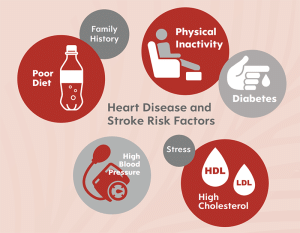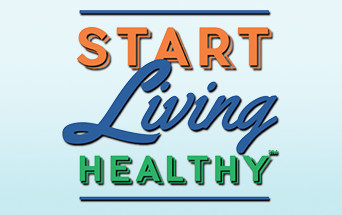Risk Factors
Click Here for:
Heart Disease and Heart Attack Risk Factors
Stroke Risk Factors
While some risk factors such as family history of cardiovascular disease or your age are out of your control, many cardiovascular disease risk factors are modifiable.
Risk factors are behaviors or conditions that increase your chances of developing cardiovascular disease. Risk factors for heart disease, heart attack and stroke are listed below and provided by the Centers for Disease Control and Prevention.
Risk Factors for Heart Disease & Heart Attack
Conditions
Blood cholesterol levels
Cholesterol is a waxy substance produced by the liver or consumed in certain foods. It is needed by the body, and the liver makes enough for the body’s needs. When there is too much cholesterol in the body-because of diet and the rate at which the cholesterol is processed-it is deposited in arteries, including those of the heart. This can lead to narrowing of the arteries, heart disease, and other complications.
Some cholesterol is often termed “good,” and some often termed “bad.” A higher level of high-density lipoprotein cholesterol, or HDL, is considered “good,” and gives some protection against heart disease. Higher levels of low-density lipoprotein, or LDL, are considered “bad” and can lead to heart disease. A lipoprotein profile can be done to measure several different forms of cholesterol, as well as triglycerides (another kind of fat) in the blood.
High Blood Pressure
High blood pressure is another major risk factor for heart disease. It is a condition where the pressure of the blood in the arteries is too high. There are often no symptoms to signal high blood pressure. Lowering blood pressure by changes in lifestyle or by medication can lower the risk of heart disease and heart attack.
Diabetes Mellitus
Diabetes also increases a person’s risk for heart disease. With diabetes, the body either doesn’t make enough insulin, can’t use its own insulin as well as it should, or both. This causes sugars to build up in the blood. About three-quarters of people with diabetes die of some form of heart or blood vessel disease. For people with diabetes, it is important to work with a healthcare provider to help in managing it and controlling other risk factors.
Behaviors
Tobacco use increases the risk of heart disease and heart attack. Cigarette smoking promotes atherosclerosis and increases the levels of blood clotting factors, such as fibrinogen. Also, nicotine raises blood pressure, and carbon monoxide reduces the amount of oxygen that blood can carry. Exposure to other people’s smoke can increase the risk of heart disease even for nonsmokers.
Diet
Several aspects of peoples’ dietary patterns have been linked to heart disease and related conditions. These include diets high in saturated fats and cholesterol, which raise blood cholesterol levels and promote atherosclerosis. High salt or sodium in the diet causes raised blood pressure levels.
Physical Inactivity
Physical inactivity is related to the development of heart disease. It also can impact other risk factors, including obesity, high blood pressure, high triglycerides, a low level of HDL (good) cholesterol, and diabetes. Regular physical activity can improve risk factor levels.
Obesity
Obesity is excess body fat. It is linked to higher LDL (bad) cholesterol and triglyceride levels and to lower HDL (good) cholesterol, high blood pressure, and diabetes.
Alcohol
Excessive alcohol use leads to an increase in blood pressure, and increases the risk for heart disease. It also increases blood levels of triglycerides which contributes to atherosclerosis.
Heredity
Heart disease can run in the family. Genetic factors likely play some role in high blood pressure, heart disease, and other vascular conditions. However, it is also likely that people with a family history of heart disease share common environments and risk factors that increase their risk. The risk for heart disease can increase even more when heredity is combined with unhealthy lifestyle choices, such as smoking cigarettes and eating a poor diet.
Sources: Content from CDC About Heart Disease, Risk Factors, https://www.cdc.gov/heartdisease/risk_factors.htm, accessed 4/27/22.
Risk Factors for Stroke
Anyone can have a stroke, but certain behaviors and medical conditions can increase your chances. Fortunately, anyone can take steps to lower their risk.
Medical Conditions
High blood pressure
High blood pressure, also called hypertension, can greatly increase your risk for stroke. Smoking cigarettes, eating a diet high in salt, and drinking too much alcohol can all raise your blood pressure.
High blood cholesterol
High blood cholesterol can build up fatty deposits (plaque) on blood vessel walls. The deposits can block blood flow to the brain, causing a stroke. Diet, exercise, and family history affect blood cholesterol levels.
Heart disease
Common heart disorders can increase your risk for stroke. For example, coronary artery disease (CAD) increases your risk because a fatty substance called plaque blocks the arteries that bring blood to the heart. Other heart conditions, such as heart valve defects, irregular heartbeat (including atrial fibrillation), and enlarged heart chambers, can cause blood clots that may break loose and cause a stroke.
Diabetes
Having diabetes can increase your risk of stroke and can make the outcome of strokes worse. Diabetes is a condition that causes blood to build up too much sugar instead of delivering it to body tissues. High blood sugar tends to occur with high blood pressure and high cholesterol.

Overweight and obesity
Being overweight or obese can raise total cholesterol levels, increase blood pressure, and promote the development of diabetes.
Previous stroke or transient ischemic attack (TIA)
If you have already had a stroke or a TIA, also known as a “mini-stroke,” there is a greater chance that you could have a stroke in the future.
Sickle cell disease
This is a blood disorder that is associated with ischemic stroke, and mainly affects African-American and Hispanic children. A stroke can happen if sickle cells get stuck in a blood vessel and clog blood flow to the brain. About 10% of children with sickle cell disease will have a stroke.
Behavior
Tobacco Use
Smoking injures blood vessels and speeds up the hardening of the arteries. The carbon monoxide in cigarette smoke reduces the amount of oxygen that your blood can carry. Secondhand smoke can increase the risk of stroke for nonsmokers.
Alcohol Use
Drinking too much alcohol raises your blood pressure, which increases the risk for stroke. It also increases levels of triglycerides, a form of cholesterol, which can harden your arteries.
Physical Inactivity
Not getting enough exercise can make you gain weight, which can lead to increased blood pressure and cholesterol levels. Inactivity also is a risk factor for diabetes.
Heredity
Family history
Having a family history of stroke increases the chance of stroke.

Age and gender
The older you are, the more likely you are to have a stroke. Men are at greater risk than women to have a stroke.
Race and ethnicity
Blacks, Hispanics, and American Indian/Alaska Natives have a greater chance of having a stroke than do non-Hispanic whites or Asians.
Sources: CDC About Stroke, Risk Factors, https://www.cdc.gov/stroke/risk_factors.htm, accessed 4/27/22.





